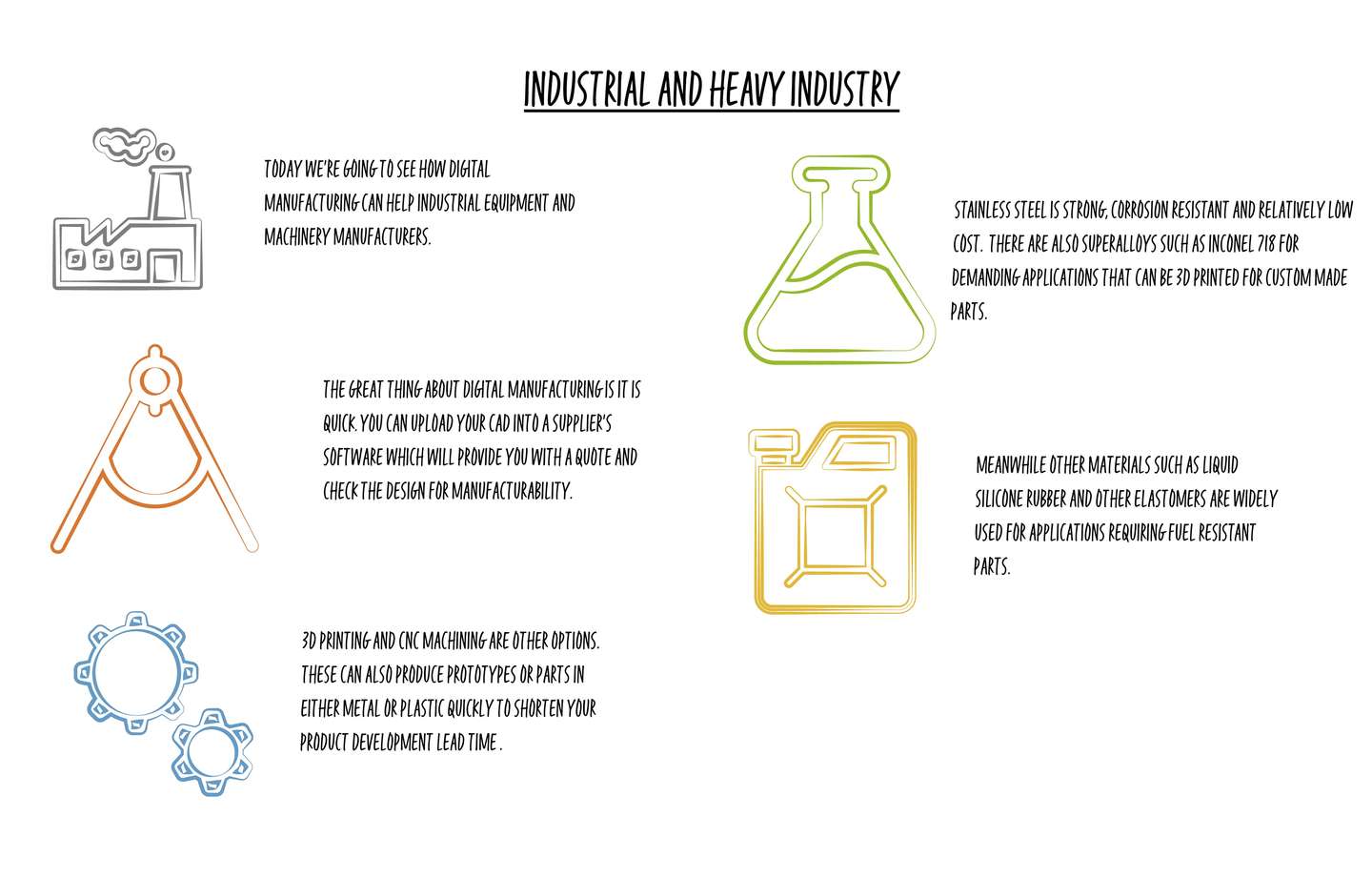
Industrial and Heavy Industry
Your masterclass in product design and development
Protolabs’ Insight video series
Our Insight video series will help you master digital manufacturing.
Every Friday we’ll post a new video – each one giving you a deeper Insight into how to design better parts. We’ll cover specific topics such as choosing the right 3D printing material, optimising your design for CNC machining, surface finishes for moulded parts, and much more besides.
So join us and don’t miss out.
Insight: Industrial and Heavy Industry
Transcript
Hello and welcome to this week’s Insight.
Today we’re going to see how digital manufacturing can help industrial equipment and machinery manufacturers.
Whether its 3D printing, CNC machining or injection moulding, advances in these technologies can help manufacturers face some of the challenges that they face in the modern world. We’ll then move onto to look at some of the more common materials that you can use with these manufacturing methods for components or parts.
Now we all know about the pace of change and how we need to embrace digital connectivity. We hear phrases like industry 4.0 and the Internet of Things all the time. It means that your equipment must feature sensors and actuators that will exchange critical data with a wider industrial network.
To compete you need to introduce new intelligent features more quickly than your competitors. This means that you need to prototype test and reiterate component and part designs rapidly.

The great thing about digital manufacturing is it is quick. You can upload your CAD into a supplier’s software which will provide you with a quote and check the design for manufacturability.
When you get the green light on the design then those parts can be delivered rapidly. In fact, it can be as short as a day.
Let’s just stop and think about that. Take injection moulding we all know that it can take weeks for steel tooling to arrive, so how can a supplier possibly turn something round that quickly?
If they are involved in rapid injection moulding, then some suppliers will use aluminium tooling which is a lot quicker to produce than steel. I won’t pretend that it’s always a perfect replacement for steel tooling, but if you need something to bridge to much higher volumes then it’s a great option.

3D printing and CNC machining are other options. These can also produce prototypes or parts in either metal or plastic quickly to shorten your product development lead time or fill in a production gap. All of this can remove weeks from your product development life cycle.
This pace of change also means that you will have to deal with a large inventory of existing equipment and machinery that is still in the market – sometimes these products may have been around for decades.
The challenge is to carry on supporting those customers who have these products, after all they could well become future customers when they decide to replace their equipment. Equally though it makes no sense to have huge inventories of spare parts and components getting dusty on warehouse shelves.
Even if you could remanufacture spare parts yourself, do you really want to hold onto those old tools and then disrupt production while you manufacture what could be small quantities?
This is where finding the right digital manufacturing partner can really pay dividends. Not only are they able to produce low volumes of plastic or metal parts on demand, but as we’ve seen they can do it quickly and in lower volumes. It is surely a more cost-effective way of keeping customers of legacy equipment happy than manufacturing the parts yourself or even keeping stock around for years.
Moving onto what material you need for that part or component; you should find that a digital manufacturer can prototype or manufacture it in pretty much any material that you might need. At Protolabs for example you can choose from more than 30 different metal alloys and hundreds of industrial grade plastics.
Let’s run through some of the more commonly used options.

Stainless steel is strong, corrosion resistant and relatively low cost. There are also superalloys such as Inconel 718 for demanding applications that can be 3D printed for custom made parts.
Another metal, aluminium is lightweight and is often chosen because its excellent machineability makes it a cost-effective material to use.
If you need to retrofit existing equipment with computer electronics, then there is a huge range of versatile and affordable thermoplastics for the housings. There are also high-performance thermoplastics such as PEEK and PEI that can serve as stand-ins for metal in some situations.

Meanwhile other materials such as liquid silicone rubber and other elastomers are widely used for applications requiring fuel resistant parts.
That really is a very brief overview of just some of the material options available to you with digital manufacturing. For many plastics and metals, you can even choose which manufacturing technology best meets your needs – whether it’s industrial 3D printing, CNC machining or injection moulding.
If I can leave you with one thought it would be this; digital manufacturing technology is advancing rapidly, which means that what you once thought was impossible or too expensive to contemplate is now a cost-effective option.
It is well worth exploring what modern digital manufacturing suppliers can offer you. They can help speed up your new product development and also produce parts for legacy products already in the market.
That’s it for this week. I look forward to seeing you again next Friday.
With special thanks to Natalie Constable.











